To understand the death of something, one must first know the conditions in which he was born. In this case, Pontiac Fiero, a GM middle engine sports car, is an idea that has long developed that is borne by the needs during the crisis period, coupled with bargaining parts and litani bad decisions.
When the 1970s gave way to the 80s, Pontiac was very desperate to attack vehicles that would return it on the map while distinguishing it from a handful of other cars in the General Motors cage. Pontiac General Manager at the time, Bill Hoglund, felt that an affordable two-seat sports car would help reclaim the performance image that was once owned by the legendary-and-later fading-gto. Hoglund wants to direct these two sporty seats in the Road Warriors who travel to work and market it as a car inhaling gas, environmentally friendly, which is able to carry out tasks around the city economically.
With the OPEC gas crisis that is still fresh in the minds of consumers, General Motors reluctantly to turn on the project but only give pontiac for only $ 700 million to complete it (through motor trends).Interestingly, Fiero actually started life in the 60s. Elliott Estes, former Chief Engineer of Pontiac (1956-1961) and General Manager (1961-1965), calling it an affordable “toy” sporty alternative for Corvette for Chevy. However, GM failed to approve a unique idea at that time (through Hagerty).
The origin of the Galirly Civil Civil Cursam
In 1978, this concept was eliminated from ES by Denny O’Donnell, Pontiac’s Strategic Planning Manager at the time, while at the Future Product Conference (FPC). FPC, ironically, was led by Elliott Estes, who since then became the President of General Motors (through Hagerty). Estes ordered a concept car, but it took half a dozen the revised year, design modification, and various general Pontiac managers before two small seats would make it produced.
In 1984, Pontiac Fiero who was plastic, which means “very proud” in Italian and “fierce” in Spanish, was released at a price of $ 7,999. At the end of the year, nearly 137,000 were on the road (through motor trends). It became a hot commodity so that zipper as a speed car for Indianapolis 500 in the same year, and the 2M4 model even made it on the list of 10-best “Cars & Drivers”.
Then, the ways of Penny-Pinching Pontiac, combined with the bargaining section used to make sporty commuter cars become a trivial amount of production … back to burn them, literally.Meanwhile it may have been handled well and changed from 0-60 in 11.3 seconds with the highest speed of 105 mph, it is full of so many parts and pieces wrapped in other GM vehicles, there is something that is definitely wrong.
Fiero a little of this and a little of it
The front, steering and brake suspension has been withdrawn from the existing chevette. GM never bothering with a power steering system because it saves more money. Driveline and rear suspension are actually the front wheel drive components released from quotes … and “upside down” (through motor trends).”Iron Duke” is 92-HP OHV 2.5-liter four-cylinder which is not suitable for high revving sports cars. The engine is a little too big for the engine compartment, so the engineers reduce the size of the oil pan.
According to one of the official GM spare parts dealers, this causes the engine to flow low in oil, which makes it easy to get too hot the engine, which leads to fire. However, as reported by Hagerty, the oil problem was caused by “dipstick which was marked incorrectly” and the owner’s manual registered an oil pan as three liters, not four liters.Whatever the problem, Fiero’s sales began to slide because of poor publicity, and the following year production fell to more than 76,000 a year later. Sales increased slightly in 1986, but once consumers advocate Ralph Nader were involved and claimed that machine problems lead to fires, sales continued to plummet until GM stopped production in 1988.




